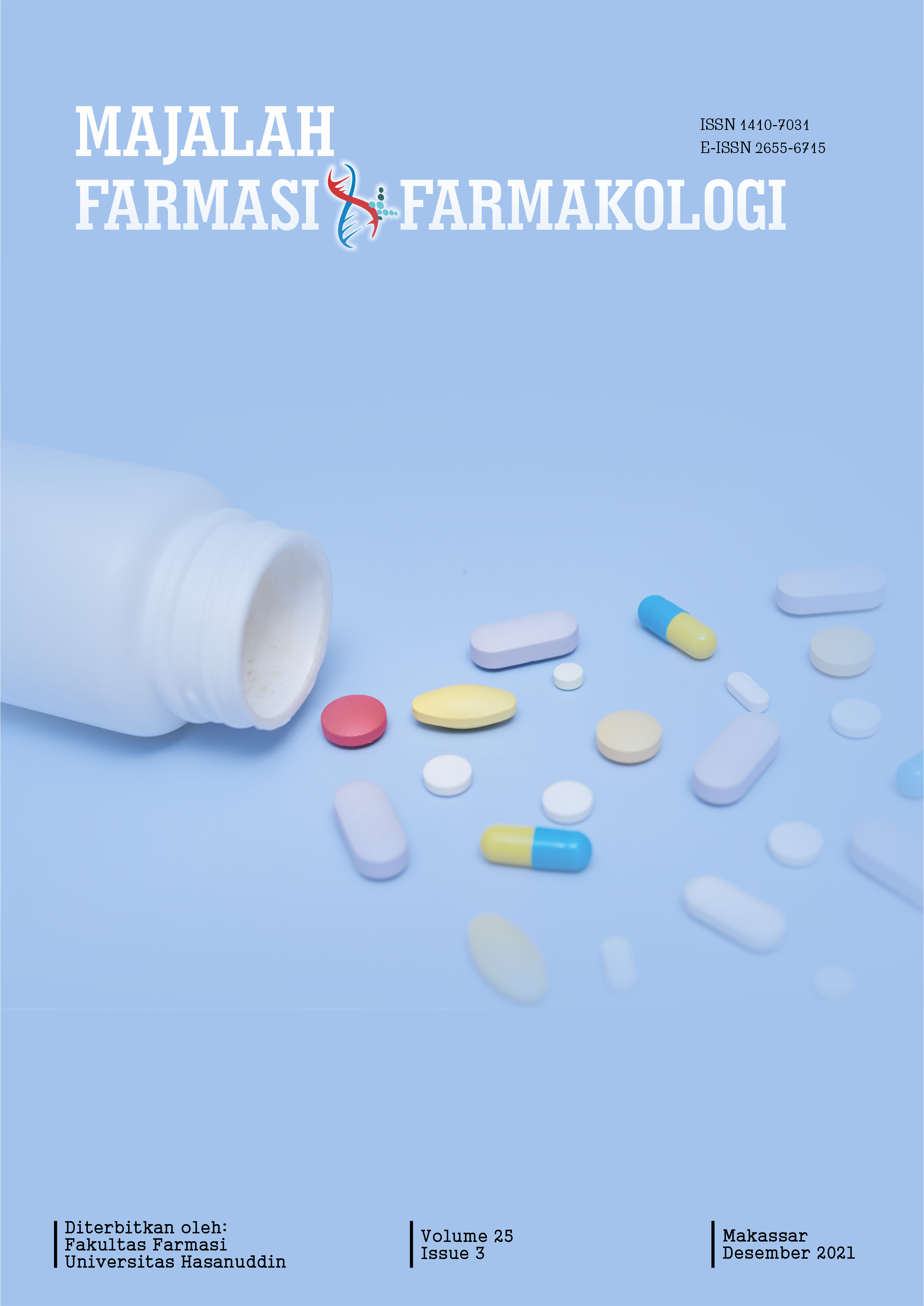PERBANDINGAN POTENSI ANTIBAKTERI INFUS AKAR KUNING (Fibraurea tinctoria Lour.) TERHADAP Staphylococcus aureus DAN Streptococcus pyogenes IN VITRO
Keywords:
antibakteri, infus, akar kuning, Staphylococcus aureus, Streptococcus pyogenes, antibakteri, infus, akar kuning, Staphylococcus aureus, Streptococcus pyogenesAbstract
Akar kuning (Fibraurea tinctoria Lour.) merupakan salah satu tumbuhan yang dipakai sebagai obat tradisional dalam bentuk rebusan oleh masyarakat Dayak Kalimantan Tengah. Bentuk sediaan infus memiliki kemiripan dengan bentuk sediaan rebusan dalam pengolahannya. Meskipun beberapa penelitian terdahulu menunjukkan ekstrak air tanaman akar kuning berefek sebagai antibakteri, namun, belum ditemukan penelitian yang membandingkan potensi antibakteri bagian akar dari tanaman ini dalam bentuk sediaan infus untuk bakteri Staphylococcus aureus (S. aureus) dan Streptococcus pyogenes (S. pyogenes). Penelitian ini bertujuan untuk menganalisis perbedaan potensi infus akar dari tanaman akar kuning terhadap pertumbuhan dua spesies bakteri tersebut secara in vitro. Penelitian ini merupakan penelitian eksperimental murni dengan rancangan post test-only with control group yang terdiri dari 3 perlakuan menggunakan variasi konsentrasi infus akar tanaman akar kuning (0,64 mg/mL, 0,32 mg/mL, 0,16 mg/mL, dan 0,08 mg/mL), eritromisin 15 μg (kontrol positif), dan akuades (kontrol negatif). Uji potensi antibakteri dilakukan dengan menggunakan metode difusi cakram (Kirby-Baeur). Parameter yang diukur yaitu diameter zona hambat bakteri di sekitar cakram (milimeter). Data dianalisis dengan menggunakan uji One-way ANOVA, uji post-hoc LSD, dan uji t-independent pada tingkat kepercayaan 95%. Analisis statistik pada hasil penelitian menunjukkan semakin besar konsentrasi infus akar kuning semakin besar daya hambatnya (p<0,001). Perbedaan konsentrasi infus pada bakteri yang sama juga menyebabkan daya hambat yang berbeda (p<0,001). Zona hambat infus akar tanaman akar kuning terhadap S. aureus lebih besar dibandingkan terhadap S. pyogenes pada konsentrasi 0,64 mg/mL dan secara statistik terdapat perbedaan yang signifikan (p<0,05). Kesimpulan dari penelitian ini adalah potensi antibakteri infus akar tanaman akar kuning lebih besar terhadap S. aureus dibandingkan terhadap S. pyogenes (p<0,05).
References
Carroll KC, Morse SA, Mietzner T, Miller S. Jawetz, Melnick, & Adelberg Mikrobiologi kedokteran. 27th ed. Jakarta: EGC; 2017.
Gahlawat G, Tesfaye W, Bushell M, Abrha S, Peterson GM, Mathew C, Sinnollareddy M, McMillan F, Samarawickrema I, Calma T, Chang AY, Engelman D, Steer A, Thomas J. Emerging treatment strategies for Impetigo in Endemic and Nonendemic Settings: A systematic review. Clinical Therapeutics. 2021; In press. corrected proof.
Norton L, Myers A. The treatment of streptococcal tonsillitis/pharyngitis in young children. World Journal of Otorhinolaryngngology-Head and Neck Surgery. 2021;7(3):161-5.
Qasanah FN. Uji aktivitas antibakteri kombinasi eritromisin dan 5 ekstrak tanaman terhadap Staphylococcus aureus resisten antibiotik [skripsi]. Surakarta: Universitas Muhammadiyah Surakarta; 2018.
Tan J, Wang Y, Gong X, Li J, Zhong W, Shan L, Lei X, Zhang Q, Zhou Q, Zhao Y, Chen C, Zhand Y. Antibiotic resistance in neonates in China 2012-2019: A multicenter study. Journal of Microbiology, Immunology and Infection. 2021. In press, corrected proof.
Du V, Dung PT, Toan NT, Mao C, Bac, NT, Tong HV, Son HA, Viet NT. High Rates if Streptococcus Agalactiae Clindamycin and Erythromycin Resistance in Vietnamese Pregnant Women. Research Square. V1.
Ali EA, Alshuaibi ONM, Ali KS. Evaluation of some antibiotic resistance in Staphylococcus aureus isolated by medical laboratories Aden, Yemen. Electronic Journals of University of Aden for Basic and Applied Sciences. 2021. 2(1). 49-53.
Kusumawati RL, Hasibuan M, Sari R. Bacterial profile and antimicrobial susceptibility pattern among patients with suspected bloodstream infection in Universitas Sumatera Utara Hospital, Indonesia. Journal of Pharmacy and Biological Sciences. 2021. 16(1): 14-7.
Larisu MA, Sudarsono, Iravati S, Nurrochmad A. Kajian ilmiah air rebusan katola (Arcangelisia flava L. Merr) obat diare berdarah masyarakat Kabupaten Muna Sulawesi Tenggara. Majalah Farmasi Indonesia. 2010;21(4):284-5.
Kaharap AD, Mambo C, Nangoy E. Uji efek antibakteri ekstrak batang akar kuning (Arcangelisia flava Merr.) terhadap bakteri Staphylococcus aureus dan Escherichia coli. J e-Biomedik (eBm). 2016;5(1):2-3.
Yamin, Hasnawati. Potensi ekstrak daun dan batang katola (Arcangelisia flava L. Merr) sebagai antimikroba. Jurnal Farmasi, Sains, dan Kesehatan. 2017;3(2):25-6.
Heryani H, Nugroho A. Study of yellow root (Arcangelisia flava Merr) as a natural food additive with antimicrobial and acidity- stabilizing effects in the production process of palm sugar. Procedia Environmental Sciences. 2015;23:347-9.
Federer W. Statistics and society : data collection and interpretation. 2th ed. New York: Marcel Dekker; 1991.
Solihah MA, Wan Rosli WI, Nurhanan AR. Phytochemicals screening and total phenolic content of Malaysian Zea mays hair extract. Int Food Res J. 2012; 19(4): 1534
Marliana SD, Suryanti V, Suyono. Skrining fitokimia dan analisis kromatografi lapis tipis komponen kimia labu siam (Sechium edule Jacq. Swartz.) dalam ekstrak etanol. Biofarmasi. 2005; 3(1); 27
Dayana P. Perbandingan efektivitas daya hambat sediaan tunggal dan kombinasi infus daun kelakai dan daun katuk terhadap Staphylococcus aureus [skripsi]. Banjarmasin; Universitas Lambung Mangkurat: 2018.
Santoso U, Utari M, Marpaung MP. Aktivitas antibakteri dan antijamur ekstrak batang akar kuning (Fibraurea chloroleuca Miers) terhadap Escherichia coli, Staphylococccus aureus dan Candida albicans. J Kesehatan Bakti Tunas Husada. 2020;20(2):194-203.
Asmardi A, Roza RM, Fitmawati. Aktivitas antibakteri ekstrak daun Cyclea barbata (L.) Miers. Terhadap bakteri Escherichia coli dan Salmonella typhi. JOM FMIPA. 2020;1(2):1-9.
Xie Y, Yang W, Tang F, Chen X, Ren L. Antibacterial activities of flavonoids: structure-activity relationship and mechanism. Current Medicinal Chemistry. 2015;22(1):132–49.
Azis. Analisis in vitro aktivitas antibakteri daun sisik naga (Drymoglossum pilosellaoides) terhadap bakteri Vibrio harveyi dan Vibrio parahaemolyticus. J of Aquaculture and Fish Health. 2019:8(2).
Cushnie TPT, Cushnie B, Lamb AJ. Alkaloids: an overview of their antibacterial, antibiotic-enhancing and antivirulence activities. Int J Antimicrob Agents. 2014;44:377–86.
Sabbineni J. Phenol-An effective antibacterial agent. JOMC. 2016;3(2):185.
Puteri T, Milanda T. Uji daya hambat ekstrak daun lidah buaya (Aloe vera L.) terhadap bakteri Escherichia coli dan Staphylococcus aureus :Review. Farmaka. 2016;14(2):2.
Kawengian SAF, Wuisan J, Leman MA. Uji daya hambat ekstrak daun serai (Cymbopogon citratus L.) terhadap pertumbuhan Streptococcus mutans. J e-Gigi (eG). 2017:5(1).
Rijayanti RP. Uji aktivitas antibakteri ekstrak etanol daun mangga bacang (Mangifera foetida L.) terhadap Staphylococcus aureus secara in vitro [skripsi]. Pontianak: Universitas Tanjungpura; 2014.
Alfiah RR, Khotimah S, Turnip M. Efektivitas ekstrak metanol daun sembung rambung (Mikania micrantha Kunth) terhadap pertumbuhan jamur Candida albicans. Jurnal Probiont. 2015;4(1):52-7.
Clinical And Laboratory Standards Institute. Performance standards for antimicrobial susceptibility testing. M 100. 28th ed. Pennsylvenia: Clinical And Laboratory Standards Institute; 2018.
Kemegne GA, Mkounga P, Essia Ngang JJE, Kamdem SLS, Nkengfack AE. Antimicrobial structure activity relationship of five anthraquinones of emodine type isolated from Vismia laurentii. BMC Microbiology. 2017;17:1–8.
Lingga, AR, Pato U, Rossi E. Uji antibakteri ekstrak batang kecombrang (Nicolaia speciosa Horan) terhadap Staphylococcus aureus dan Escherichia coli. JOM Faperta. 2016;3(1):1-15.
Permata P, Kawuri R, Darmadi AAK. Uji aktivitas antibakteri ekstrak etanol kulit buah manggis (Gracinia mangostana L.) terhadap pertumbuhan bakteri Escherichia coli. J Simbiosis. 2018;6(1):7-11.
Indrawati I, Rizki AFM. Potensi ekstrak buah buni (Antidesma bunius L.) sebagai antibakteri dengan bakteri uji Salmonella thypimurium dan Bacillus cereus. Jurnal Biodjati. 2017;2(2):143-4.
Levinson W. Review of medical microbiology and immunology. 13th ed. Philadelphia: McGraw-Hill Education; 2014.
Susmitha AN. Uji efektivitas antibakteri ekstrak etanol eceng gondok (Eichhornia crassipes) terhadap bakteri karies gigi Streptococcus mutans dan Staphylococcus aureus ATCC 25923 [skripsi]. Yogyakarta: Universitas Islam Negeri Sunan Kalijaga; 2019.
Murray PR, Rosenthal KS, Pfaller MA. Medical microbiology. 8th ed. Philadelphia: Elsevier; 2016.
Yohanes, Khotimah S, Ilmiawan MI. Uji aktivitas antibakteri infusa daun paku sisik naga (Drymoglossum piloselloides L.) terhadap Streptococcus pyogenes. Jurnal Mahasiswa PSPD FK Universitas Tanjungpura. 2018;4(1):16-7.
Ansel HC. Pengantar bentuk sediaan farmasi. 4th ed. Jakarta: UI Press; 2005.
Badan Pengawas Obat dan Makanan (BPOM) Republik Indonesia. Acuan sediaan herbal volume kelima. Edisi 1. Jakarta: BPOM RI; 2010.
Yanti YN. Infusa daun randu (Ceibapetandragaertn) untuk formulasi obat kumur. J Ilm Ibnu Sina. 2017;2(2):225-231.
Rahman A, Taufiqurrahman I, Edyson. Perbedaan total flavonoid antara metode maserasi dengan sokletasi pada ekstrak daun ramania (Bouea macrophylla Griff). Dentino. 2017;1(1):26.
Novitasari IW. Uji aktivitas antibakteri infusa daun mangga bacang (Mangifera foetida L.) terhadap pertumbuhan Salmonella typhi [skripsi]. Pontianak: Universitas Tanjungpura;2015.
Marnoto T, Haryono G, Gustinah D, Putra FA. Ekstraksi tanin sebagai bahan pewarna alami dari tanaman putrimalu (Mimosa pudica) menggunakan pelarut organik. Reaktor. 2012;14(1):39-45.
Susilawati M. Perancangan percobaan. Denpasar: Universitas Udayana; 2015.
Dewoto HR. Pengembangan obat tradisional Indonesia menjadi fitofarmaka. Departemen Farmakologi, Fakultas Kedokteran Universitas Indonesia. 2007; 57(7): 205-11.
Sari AA, Saleh C, Erwin. Uji fitokimia, toksisitas dan aktivitas antibakteri ekstrak berbagai fraksi daun mara (Macarangatanarius (L.) M.A) terhadap bakteri Staphylococcus aureus dan Escherichia coli. Jurnal Kimia Mulawarman. 2015; 12(2): 53-58.
Downloads
Published
Issue
Section
License
Copyright (c) 2021 Majalah Farmasi dan Farmakologi

This work is licensed under a Creative Commons Attribution-NonCommercial 4.0 International License.
The copyright to this article is transferred to Universitas Hasanuddin (UNHAS) if and when the article is accepted for publication. The undersigned hereby transfers all rights in and to the paper including without limitation all copyrights to UNHAS. The undersigned hereby represents and warrants that the paper is original and that he/she is the author of the paper, except for material that is clearly identified as to its original source, with permission notices from the copyright owners where required. The undersigned represents that he/she has the power and authority to make and execute this assignment.
We declare that:
- This paper has not been published in the same form elsewhere.
- It will not be submitted anywhere else for publication prior to acceptance/rejection by this Journal.
- A copyright permission is obtained for materials published elsewhere and which require this permission for reproduction.
Furthermore, I/We hereby transfer the unlimited rights of publication of the above-mentioned paper in whole to UNHAS The copyright transfer covers the exclusive right to reproduce and distribute the article, including reprints, translations, photographic reproductions, microform, electronic form (offline, online) or any other reproductions of similar nature.
The corresponding author signs for and accepts responsibility for releasing this material on behalf of any and all co-authors. This agreement is to be signed by at least one of the authors who have obtained the assent of the co-author(s) where applicable. After submission of this agreement signed by the corresponding author, changes of authorship or in the order of the authors listed will not be accepted.


